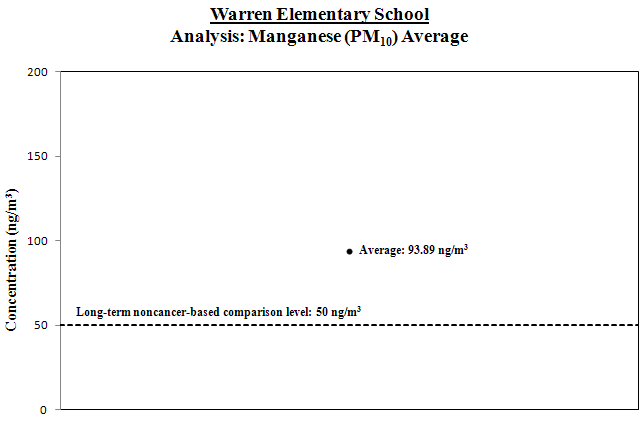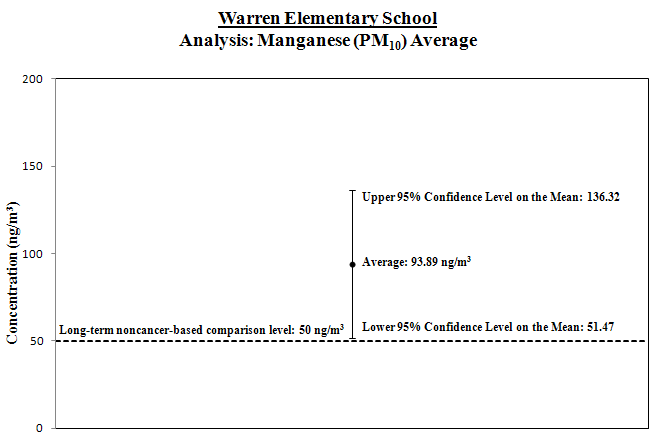Assessing Outdoor Air Near Schools
Warren Elementary School - Marietta, OH
- Understanding the Monitoring Data
- Initial Sample Results
- Initial Analysis
- Additional Sample Results
- Final Analysis
Results and Analysis of EPA’s monitoring
EPA selected this school for monitoring because it was located near a coke oven and steel manufacturing facility which are sources of air toxics emissions. Air monitoring was initially conducted at Warren Elementary School (Warren), Ohio Valley Educational Service Center (Ohio Valley) and at Neale Elementary School (Neale) from August 17, 2009 through November 15, 2009 to assess concentrations of manganese in the air. EPA extended air toxics monitoring at Warren, not Ohio Valley or Neale, because measurements of manganese were elevated and indicated a potential concern for long-term, continuous exposure. Additional monitoring for manganese was conducted from December 23, 2011 through February 25, 2012.
| Primary Findings | The second round of monitoring indicates that the longer-term concentration estimates for manganese (PM10) indicate the potential for levels of health concern for long-term continuous exposures. |
| Key Pollutants Monitored | Manganese. Inhalation may affect the nervous system if people are exposed to high levels. |
| Next Steps | EPA promulgated a Notice of Proposed Rule Making for Risk and Technology Review for Ferroalloy Production on November 23, 2011, and there is a consent decree for a Final Rule with a required signature on December 10, 2013. This rule is intended to address manganese at the source. The Ohio Environmental Protection Agency (OEPA) is aware of these monitored values, which are consistent with historical values in this area, and will continue to oversee industrial facilities in the area through air permits and other programs. The OEPA continues to monitor metals in total suspended particulates (TSP) in the area. |
Summary of Study Approach and Findings
Approach:
- A monitor collected air samples from December 23, 2011 through February 25, 2012 at Warren Elementary in Marietta, Ohio.
- Individual air sample results are posted on this website.
- When the monitoring was complete, we analyzed the results to see if there was a concern from long-term concentrations (over a lifetime).
- Also, when the monitoring was complete, we evaluated all the air samples from the on-site monitor.
Findings:
- Measured values of manganese indicate an influence of the source at the school.
- Levels of manganese remain above levels of concern for long-term exposure at the school.
- Information about Eramet indicates that the facility had no significant change in production during the monitoring period.
- Click here for additional information
How We Analyzed the Information We Collected at this School
The analysis considered whether the information collected at the school might raise concerns for the health of children or adults at the school. We looked at the following types of information:
- Measured concentrations and information on manganese
- Information about nearby sources of manganese
Analysis of Measured Manganese Concentrations:
1. Calculate the average: We calculated the average of the manganese measurements (shown by the black diamond in the graph below). We compared this average to the long-term comparison level (thick line on the graph below).
Result: The average manganese level for the samples collected remained above the long-term comparison level at Warren Elementary.

2. Calculate a range: To account for varying air concentrations of manganese, we calculated a range around the average. We did this by estimating high and low values that the longer-term concentrations might reach using common statistical tools. We compared the highest point in the range (called the “upper bound”) to the long-term comparison level.
Result: The high end of the range is above the comparison level at Warren Elementary.

Analysis of Information on Nearby Source of Manganese Emissions
| What we looked at | What we found |
Whether we could determine if the source was operating as usual during the sampling period |
Information about Eramet indicates that the facility had no significant change in production during the monitoring period. |
Eramet is subject to the National Emissions Standards for Hazardous Air Pollutants (NESHAP) Maximum Achievable Control Technology (MACT) for the Ferroalloys Production source category and was the only source covered when the MACT standard was developed. Since then several other sources have become subject to the MACT standard. Eramet has a CAA Title V operating permit issued by OEPA that includes operating requirements |
Additional Information
Technical Report for School: Assessing Outdoor Air Near Schools: Additional Monitoring at Warren Elementary School (Marietta, Ohio) (PDF) (26pp,152k). The technical report is a follow-up to the original monitoring. The report is geared toward risk assessors, risk managers, and other regulatory agencies.
